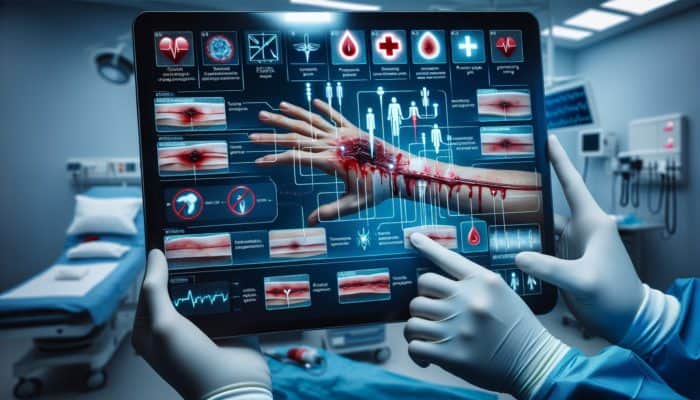Comprehensive Overview of Bleeding Types and Their Management
Identifying Various Types of Bleeding
Bleeding Control Tips: Understanding the different categories of bleeding—arterial, venous, and capillary—is vital for effective medical intervention and treatment. Arterial bleeding is marked by bright red blood that spurts rhythmically with the heartbeat, indicating that it originates from high-pressure blood vessels. This type of bleeding necessitates immediate medical attention due to the rapid loss of blood that can lead to serious complications. In contrast, venous bleeding involves a steady flow of darker blood and originates from veins, which operate under lower pressure than arteries. While venous bleeding can also be serious, it may not require the same level of urgent intervention as arterial bleeding. Finally, capillary bleeding typically occurs as a result of minor injuries, such as cuts or scrapes, where blood oozes from the surface and often stops on its own without requiring extensive treatment.
Each type of bleeding calls for specific and tailored interventions. For instance, while applying pressure is crucial for controlling bleeding in all cases, the techniques employed differ significantly. For arterial bleeding, applying direct pressure to the wound is essential. If the bleeding persists despite these efforts, a tourniquet may become necessary. By understanding the distinctions between the types of bleeding, individuals can enhance their ability to respond effectively in emergencies, thereby improving outcomes for those who are injured.
Recognising Critical Signs of Severe Bleeding
Being able to identify the signs of severe bleeding is critical for ensuring timely and effective intervention. Symptoms such as rapid blood loss, pale skin, weakness, rapid heartbeat, and confusion often indicate a life-threatening situation. Immediate action taken in response to these symptoms can prevent further complications and potentially save lives. Key signs to monitor for include:
- Bright red, spurting blood
- Dark red, steady blood flow
- Pale or clammy skin
- Weakness or dizziness
- Rapid breathing or heart rate
- Confusion or loss of consciousness
Recognising these symptoms empowers caregivers and bystanders to take immediate action without delay. It is always prudent to err on the side of caution; if you suspect someone is experiencing severe bleeding, take rapid measures to control the situation and seek professional medical assistance as soon as possible.
Why Quick Response is Crucial in Bleeding Emergencies
Taking swift action in response to bleeding can be the determining factor between life and death. The quicker that bleeding is controlled, the higher the likelihood of a favourable outcome. When an injury occurs, the body initiates a natural clotting process; however, this process can be overwhelmed if bleeding is allowed to continue unabated. Every second is crucial; thus, any delays in response can result in increased blood loss and potentially dire consequences.
A prompt response not only mitigates immediate risks but also helps to prevent long-term complications and enhances recovery outcomes. Practising emergency response techniques and being prepared to act decisively can make a significant difference in critical situations, reinforcing the idea that knowledge and readiness indeed save lives.
Expert Recommendations for Effective Bleeding Control Techniques

Mastering the Application of Direct Pressure
Applying direct pressure to a wound is the most effective initial step in controlling bleeding. This technique encourages the clotting process by compressing the blood vessels at the site of injury. For instance, in a situation where an individual suffers a severe cut while hiking, applying firm, consistent pressure can substantially slow or even halt the bleeding.
To effectively apply direct pressure, it is essential to use a clean cloth or a sterile bandage and press down firmly on the wound. It is important to avoid lifting the cloth to check the wound, as this can disrupt the clotting process and lead to further blood loss. If blood soaks through the initial layer, apply additional layers on top rather than removing the original cloth. In a practical scenario, a quick-thinking bystander at a cycling accident managed to apply pressure to a cyclist’s arterial wound, effectively maintaining blood flow until emergency services arrived.
This highlights the importance of understanding and applying direct pressure as a life-saving technique that can be learned and utilised by anyone in critical moments.
How to Use Tourniquets Effectively
Tourniquets can be essential tools in severe bleeding situations; however, they should be used judiciously and only as a last resort. Correct application can be the difference between saving a life and causing irreversible harm. To use a tourniquet effectively, follow these actionable steps:
1. Identify the site of bleeding and ensure that you have access to a commercial tourniquet or a suitable alternative (such as a belt or cloth).
2. Position the tourniquet above the injury site, ideally 2-3 inches above the wound.
3. Tighten the tourniquet until the bleeding ceases, ensuring it is secure but not so tight as to cause additional injury to the limb.
4. Record the time of application, as prolonged use can result in tissue damage.
An illustrative example of correct tourniquet use involves military personnel who are trained to apply them during combat situations, where time and effectiveness are crucial. They recognise that while a tourniquet can indeed save a life, improper application can lead to severe complications, reinforcing the necessity for thorough training and understanding.
When is it Necessary to Seek Professional Medical Assistance?
Knowing when to seek medical help is a vital skill in any emergency involving bleeding. Severe cases often require professional intervention, particularly if bleeding does not cease within a few minutes or is of a grave nature. Signs that indicate the need for immediate medical attention include:
– Persistent bleeding despite the application of pressure
– Large, deep wounds
– Signs of shock, such as confusion or extreme fatigue
– The presence of a foreign object embedded in the wound
Expert analyses stress that while self-care measures can be effective for minor injuries, recognising one’s limitations is crucial. For instance, significant arterial bleeding, such as that resulting from a traumatic injury, not only necessitates immediate first aid but also requires urgent medical care to prevent potential complications. Understanding these thresholds empowers individuals to make quick, informed decisions during crises.
Elevating the Injured Area to Control Bleeding
Elevating the injured limb above heart level is a practical technique that can effectively reduce bleeding. This method works by slowing the blood flow to the injury site, thereby allowing the body’s natural clotting mechanisms to take effect. For example, if a person sustains a leg injury, elevating the limb on a cushion or a stack of clothing can be an effective strategy to minimise blood loss while awaiting professional assistance.
Practical tips for effective elevation include positioning the limb on a stable surface and ensuring it remains elevated for the entire duration of the bleeding. This approach has been successfully employed in various scenarios, including sports injuries, where quick thinking can stabilise the situation before paramedics arrive. By strategically utilising elevation, individuals can enhance their capabilities in managing bleeding emergencies effectively.
How Can You Prepare for Emergencies Effectively?
Creating a Comprehensive Emergency Kit
Having a well-stocked first aid kit is essential for effectively managing bleeding emergencies. An efficient emergency kit should include items specifically designed to control bleeding and treat injuries. Essential components of an emergency kit include:
- Sterile gauze pads
- Adhesive bandages in a variety of sizes
- Elastic bandages for compression
- Tourniquets
- Antiseptic wipes or solutions
- Scissors and tweezers
- Disposable gloves
- Emergency blankets
By ensuring that all these items are included in your emergency kit, individuals will be better prepared to respond effectively to a range of bleeding scenarios. Additionally, regularly checking the kit for expired items and replacing those that have been used will further enhance readiness and ensure that supplies remain effective and safe to use.
A well-prepared emergency kit empowers individuals to confidently manage bleeding incidents, whether they occur at home, during outdoor activities, or at work.
Investing in Training and Education for Preparedness
Learning how to control bleeding through formal courses or online resources can be a life-saving investment. Regular practice ensures that individuals are always ready and instills a sense of confidence in their ability to manage emergencies effectively. The benefits of regular training extend to improved response times, enhanced knowledge of techniques, and a heightened sense of preparedness.
Courses often cover critical topics such as applying direct pressure, understanding when to implement a tourniquet, and recognising the signs of severe bleeding. For example, individuals trained in first aid have reported feeling more capable and confident during emergencies, which can make a significant difference in critical scenarios. Furthermore, engaging in community training sessions or workshops fosters a culture of safety that extends beyond the individual, positively impacting families, workplaces, and broader communities.
Establishing a Well-Defined Emergency Plan
Having a comprehensive emergency plan in place can streamline responses during crises. This plan should outline the roles and responsibilities of all family members or colleagues involved. An effective emergency plan includes clear steps for various potential situations, ensuring that everyone knows what actions to take in the event of an emergency.
To engage family members in the plan’s development, conduct family meetings to discuss potential scenarios and review established procedures collectively. This collaborative approach not only empowers individuals but also fosters a sense of accountability and teamwork. For instance, designating one family member as the primary first responder can help streamline actions during an emergency, allowing others to take on specific roles, such as calling for professional help or gathering necessary supplies.
By creating a well-defined emergency plan and involving everyone in its development, families can enhance their resilience and readiness for unexpected situations, ensuring that they can act cohesively during crises.
Conducting Regular Drills and Simulations for Practice
Conducting regular emergency drills is a crucial aspect of practising the emergency plan and improving response times. These drills should mimic real-life scenarios, allowing participants to practice their assigned roles effectively. Practising scenarios, such as responding to a severe bleeding incident, can build confidence and readiness among individuals.
It is recommended to schedule these drills at least once or twice a year, adjusting the frequency based on the environment and specific risks present. For instance, workplaces with a higher propensity for injuries may conduct them more frequently than typical office settings. After the drill discussions, post-drill feedback can also provide valuable insights and improve overall effectiveness during real emergencies.
By prioritising regular drills, individuals and teams can ensure they remain prepared and capable of responding effectively when actual emergencies arise, reinforcing their confidence and ability to act decisively.
Techniques for Managing Different Scenarios of Bleeding
Effective Management of Cuts and Abrasions
For minor cuts and abrasions, proper management typically involves cleaning the injury thoroughly and applying pressure to stop the bleeding. Begin by gently washing the wound with clean water or a saline solution to remove any debris. Once the area is clean, apply firm pressure with a sterile cloth or bandage for several minutes until the bleeding ceases.
Dressing the wound is equally important to protect it from potential infections. Use a sterile dressing and secure it in place with adhesive bandages. In situations where bleeding does not stop, it is essential to seek medical attention promptly. Minor cuts can escalate into more serious conditions if they are not properly and promptly managed.
If bleeding persists after applying pressure for 10 minutes, it is advisable to seek professional help without delay. Understanding this process can empower individuals to respond effectively to minor injuries, minimising complications and promoting faster healing.
Calmly Managing Nosebleeds
Managing nosebleeds requires a composed approach and adherence to specific techniques. The most effective method involves tilting the head slightly forward and pinching the nostrils together for 10-15 minutes. This position helps to prevent swallowing blood, which can irritate the stomach and potentially lead to nausea.
If the bleeding does not stop after 15 minutes, or if the nosebleed is recurrent or caused by an injury, it is essential to seek medical attention. Additionally, avoid tilting your head back, as this can cause blood to flow down the throat and complicate the situation.
Understanding these techniques equips individuals to manage nosebleeds effectively, providing immediate relief while also reducing the likelihood of further complications that could arise from improper handling.
Recognising and Responding to Internal Bleeding
Internal bleeding is a serious medical condition that can be life-threatening and requires immediate medical intervention. Recognising the signs of internal bleeding, such as abdominal pain, bruising, or lightheadedness, is crucial for effective response. In instances where individuals experience these symptoms, it is crucial to remain still and seek emergency medical assistance without delay.
Internal bleeding can stem from various causes, including trauma, underlying medical conditions, or complications arising from surgical procedures. The importance of recognising these signs cannot be overstated, as early intervention can be critical in preventing life-threatening outcomes.
For instance, individuals involved in an accident may initially appear to be unharmed but later develop symptoms indicative of internal bleeding. Understanding the nuances of such situations can empower individuals to advocate for themselves or others effectively, ensuring timely medical care is received when needed.
What Are the Best Practices for Effective Wound Care?
Steps for Proper Wound Cleaning
Proper wound cleaning is essential to minimise the risk of infection. Begin by washing your hands thoroughly with soap and water, and then gently clean the wound using sterile saline or clean water to flush out any debris or contaminants.
Steps for cleaning a wound include:
- Wash your hands thoroughly with soap and water.
- Rinse the wound under clean, running water.
- Use sterile saline if available to irrigate the wound.
- Pat the area dry with a clean cloth.
- Apply an antiseptic if appropriate to prevent infection.
- Cover the wound with a sterile dressing for protection.
By following these steps diligently, individuals can significantly minimise the risk of infection and promote faster healing. Proper cleaning is not merely about removing dirt; it also prepares the wound for subsequent care, establishing a strong foundation for recovery and health.
Effective Dressing and Bandaging Techniques
Applying a sterile dressing is crucial for protecting a wound and promoting healing. The type of dressing selected should correspond to the nature and severity of the wound. For instance, larger wounds may require more absorbent dressings, while smaller cuts might only necessitate simple adhesive bandages.
Secure the dressing in place using adhesive strips or bandages to prevent contamination. Regularly assessing the wound’s condition is also essential; if the dressing becomes wet or soiled, it should be changed promptly to reduce the risk of infection developing.
Understanding the appropriate types of dressings for various wounds enables individuals to manage injuries effectively, fostering a deeper sense of confidence in their ability to provide care and support to themselves or others.
Monitoring Wounds for Signs of Infection
Monitoring a wound for signs of infection is critical for ensuring proper healing and recovery. Key indicators of infection include redness, swelling, pain, and the presence of pus. Early detection of these symptoms can prevent complications, ensuring timely treatment is administered.
If any of these signs are observed, particularly if they worsen over time or are accompanied by fever, seeking medical attention promptly is essential. Educating oneself on how to identify these symptoms can greatly enhance one’s ability to manage wounds effectively.
Infections can significantly complicate the healing process, leading to longer recovery times and increased healthcare needs. By staying vigilant and informed, individuals can navigate the recovery process more effectively, thereby reducing the risk of severe complications.
Research-Backed Benefits of Effective Bleeding Control Techniques
Strategies for Reducing Blood Loss
Implementing effective bleeding control techniques can substantially reduce blood loss, potentially leading to improved patient outcomes. Strategies such as applying direct pressure, using tourniquets appropriately, and understanding the various types of bleeding have all demonstrated their efficacy in clinical settings.
Research indicates that early intervention in bleeding situations is associated with more favorable outcomes. For example, patients who receive immediate first aid for arterial bleeding often experience lower rates of morbidity and mortality compared to those who do not receive timely care. By understanding and implementing these techniques, individuals can significantly enhance their own safety and well-being in emergency situations.
How Emergency Control Can Improve Survival Rates
The prompt and correct application of bleeding control techniques can significantly enhance survival rates during emergencies. Statistics reveal that the timely application of first aid techniques reduces mortality rates in trauma cases. For instance, studies show that victims of traumatic injuries who receive immediate bleeding control have a markedly higher survival rate than those who do not receive timely intervention.
This underscores the critical importance of effective bleeding control in emergencies, highlighting the necessity for proper training and preparedness. Empowering individuals with knowledge regarding bleeding control can be pivotal in enhancing survival rates during crises, ensuring that lives are saved.
Enhancing Recovery Time through Effective Bleeding Management
Proper bleeding control can expedite recovery by minimising complications that arise from untreated injuries. In scenarios where bleeding is managed effectively, patients often experience shorter recovery times and fewer medical complications.
Expert analysis suggests that controlling blood loss swiftly reduces the risk of conditions such as shock, thereby allowing for more efficient healing processes. Consequently, understanding the relationship between bleeding control and recovery can motivate individuals to prioritise first aid training and preparedness for potential emergencies.
What Are Common Mistakes to Avoid During Bleeding Emergencies?
Avoiding Incorrect Tourniquet Application
Improper use of tourniquets can lead to further ineffective bleeding control. Common mistakes include over-tightening the tourniquet or leaving it on for too long, both of which can result in significant tissue damage and complications.
Understanding the risks associated with incorrect tourniquet application is essential for effective emergency response. When applied correctly, a tourniquet can save a life; however, misuse can lead to severe complications. Awareness of these pitfalls can enhance individuals’ confidence in their ability to apply tourniquets effectively and safely.
Recognising the Dangers of Delaying Treatment
Delaying treatment in bleeding situations can exacerbate the condition and lead to serious consequences. Immediate action is crucial for controlling bleeding effectively to prevent further complications. To ensure a quick response during an emergency, individuals must be prepared to act without hesitation.
Educating oneself about the urgency of bleeding control can foster swift decision-making in critical moments. Familiarising yourself with common bleeding scenarios can enhance preparedness and strengthen your ability to respond promptly and effectively in crises.
The Risks of Ignoring Signs of Internal Bleeding
Neglecting signs of internal bleeding can be fatal. Recognising and addressing these signs promptly is essential for effective intervention. Common symptoms to be vigilant for include:
- Severe abdominal pain or swelling
- Bruising without an obvious cause
- Confusion or weakness
- Rapid heart rate or shallow breathing
Understanding these indicators empowers individuals to take appropriate action in emergencies, potentially saving lives by ensuring timely access to medical care.
Maintaining Ongoing Readiness and Preparedness for Emergencies
Regularly Updating First Aid Supplies
Keeping your first aid kit up to date is crucial to ensure you have the necessary supplies for effective bleeding control. Regularly check expiration dates on items such as bandages, antiseptics, and medications, replacing them as needed to maintain their efficacy.
An effective strategy for maintaining your supplies involves creating a detailed checklist for your emergency kit, which helps streamline the organisation process and ensures that nothing is overlooked. Having a well-maintained first aid kit not only enhances individual preparedness but also fosters a culture of safety within groups or families, reassuring everyone that they are equipped to handle emergencies competently.
Staying Informed on Best Practices in Bleeding Control
Remaining informed about the latest techniques in bleeding control can significantly enhance your preparedness during emergencies. Regularly reviewing and updating your knowledge through reputable sources, such as first aid courses or instructional webinars, is essential to staying current.
Engaging with community programs or workshops can also provide valuable insights into best practices. The evolving nature of first aid knowledge underscores the importance of continuous learning. By prioritizing education, individuals can feel empowered to manage bleeding effectively in emergencies, thereby enhancing their confidence and capability to respond.
Practising Emergency Drills for Effective Response
Regular emergency drills can improve your response time and effectiveness in real emergencies. Practising various scenarios enables individuals to build confidence and readiness. Conducting drills at least a few times a year can reinforce essential skills and ensure familiarity with procedures.
Involving family or team members in these drills fosters collaboration and teamwork, contributing to a comprehensive understanding of the emergency plan. Practising together enhances overall preparedness and strengthens the ability to respond effectively when crises arise, ensuring a cohesive approach to managing emergencies.
Frequently Asked Questions about Bleeding and Wound Care
What are the most common types of bleeding that one should know about?
The most common types of bleeding include arterial, venous, and capillary bleeding. Each type exhibits distinct characteristics and requires specific interventions for effective control and management.
How do you recognise severe bleeding in an emergency?
Severe bleeding is recognised by bright red blood that spurts, rapid blood loss, pale skin, weakness, and confusion. Immediate action is necessary to prevent further complications and ensure safety.
What is the most effective way to stop bleeding at home?
The best way to stop bleeding at home is to apply direct pressure to the wound using a clean cloth or bandage, maintaining pressure until the bleeding stops completely.
When should I consider using a tourniquet in a bleeding emergency?
A tourniquet should be used as a last resort for severe bleeding that cannot be controlled by direct pressure alone. It must be applied above the injury site, and the time of application should be noted for medical personnel.
What are the signs of infection that I should look for in a wound?
Signs of infection include increased redness, swelling, pain, warmth, pus, and fever. Early detection is critical for effective treatment and preventing complications.
How often should I check and maintain my first aid kit?
You should check your first aid kit at least once every three to six months, ensuring all supplies are up-to-date, in good condition, and ready for use in emergencies.
What steps should I take if I suspect internal bleeding?
If you suspect internal bleeding, seek emergency medical attention immediately. Avoid moving and try to remain calm until help arrives to ensure your safety.
Can I manage a nosebleed at home, and if so, how?
Yes, you can manage a nosebleed at home by pinching the nostrils together and tilting the head forward for about 10-15 minutes. If the bleeding persists, seek medical help promptly.
How can I effectively prepare my family for emergencies?
You can prepare your family by creating a comprehensive emergency plan, conducting regular drills to practice responses, and ensuring that everyone is familiar with first aid techniques and has access to necessary supplies.
What are the best practices for ensuring effective wound care?
Best practices for wound care include thoroughly cleaning the wound, applying a sterile dressing, and monitoring for signs of infection to promote healing and prevent complications.
Explore our world on X!
Emergency Wound Care: Essential Techniques and Tips
Comprehensive Guide to Emergency Wound Care What constitutes emergency wound care? Emergency Wound Care: Emergency wound care represents a vital aspect of first aid, focusing on the immediate treatment of injuries to avert further harm and infection. This type of care is crucial for stabilising the injury until professional medical assistance is accessible. The primary objective […]
Surviving a Heatwave: Essential Tips and Strategies
Essential Steps for Preparing for Extreme Heat Building Your Supply Kit for Heatwaves Surviving a Heatwave: When gearing up for an impending heatwave, it is vital to ensure you have an ample supply of essentials for your well-being. The most crucial item on your list should be water; aim to have at least one gallon […]
Water Safety Tips: Essential Guidelines for All
Comprehensive Guide to Water Hazards and Safety Water Safety Tips: Water is an enchanting element, inviting us to immerse ourselves and discover its mysteries. However, it also hides numerous dangers that can transform a delightful day out into a tragic event. A profound understanding of these hazards forms the basis of effective water safety tips. […]
Burn Treatment Guide: Essential Steps and Care
Comprehensive Guide to Understanding Burn Types and Their Severity Burn Treatment Guide: Burns are far more than simple injuries; they can profoundly affect one’s quality of life and overall well-being. A thorough burn treatment guide begins with a detailed understanding of the various types and severities of burns. Recognising the differences among burn types is […]






This overview brilliantly highlights the critical differences in bleeding types and their immediate management—the urgency in dealing with arterial bleeding is something everyone should be aware of! I find it fascinating how advancements in first aid technology, like hemostatic gauzes and wound packing kits, have transformed emergency response capabilities. In my own experience, the training I received in a first aid class really opened my eyes to the importance of quick, informed action. It’s amazing how something as simple as knowing the difference between arterial and venous bleeding can make such a significant impact on outcomes. Has anyone else had a memorable experience in a first aid course or a situation where knowledge of bleeding types really came into play?